As the centenary of the Great War approached interest in the whole story of the war increased.
Programmes on television meant that we were reliving much of it. This interest has carried on to the story of the Second World War.
The Yeomanry memorial
At the entrance to Dunbar Parish church is the monument erected to the memory of those members of the Lothians and Berwickshire Imperial yeomanry who perished in the war in South Africa in1900-01.The monument is an obelisk of Corncockle red sandstone 22 feet high on a pedestal on four steps It faces the public road. On that face is the regimental badge. The monument remembers the dead of 19th Company. Eleven names are recorded*.
The fourth panel remembers the later wars and is now treated as the front. It states that the names of the fallen are recorded in Edinburgh Castle. A short wreath laying ceremony is held after the church service on Remembrance Sunday. The names of the fallen are now also contained in books of remembrance in the church, where the regimental guidon is laid up and where there is a stained glass window commemorating the regiment.
The regimental association came annually to the church on Remembrance Sunday until it wound up in 2009. Lt Col Alan Waterston, and after his death, Mrs Waterston has arranged for a wreath to be laid and flowers to be provided for Remembrance Sunday.
The Scottish Yeomanry was formed in 1992 and the HQ squadron was called Lothians and Border Horse. It was disbanded in 1999. The Scottish and North Irish Yeomanry was formed on 31st October 2014 and E Squadron was named Lothians and Border Horse. In 2015 two officers from the revived squadron of Lothians Border Horse attended on Remembrance Sunday and the interest of the squadron has continued. It was granted the Freedom of East Lothian by East Lothian Council on 6th July 2019 and at the conclusion of the ceremony paraded to the memorial where I received them on behalf of the Community Council and a rededication service was held. They also expressed interest in the church and in Sgt Penn’s grave.
Dunbar Parish War Memorial
Dunbar has a fine war memorial. It was the work of F E B Blanc and was erected by George Cunningham, builder, in Dunbar. It is an elegant Celtic cross without a Nimbus. It is made of Creetown granite with a base of Catcraig limestone. It has a bronze crucifix and I H S [Jesus]on the rear. It is perhaps an unexpected design for a Scottish town. It was originally placed on the point closer to the sea, which gradually undercut it and it was moved in 1989.
It was unveiled on Sunday 3rd. July 1921 by General Sir Reginald Wingate Bart. who handed it over to the care of the Provost. Wingate’s son Malcolm Roy Wingate was one of the fallen recorded on the memorial. Further names were added to record the dead of the second war. They were dedicated on the 2nd June 1949.The name of Guardsman Dennis Moore who was killed in Malaya on 25th September 1949 was added later.
By 2014 the memorial was looking in need of maintenance and Herbert Coutts suggested it would be a fitting tribute if the Community Council was to launch a campaign to have it restored for the centenary. The Community Council set up a group under his chairmanship from the Community Council and with representatives of The Royal British Legion and Dunbar History Society to consider the matter.
The committee decided that it should attempt to carry out a programme of restoration. It was necessary to establish our competence to do so. It was confirmed that the memorial was held by East Lothian Council. They were agreeable that the Community Council should proceed. Herbert involved Bob Heath a conservation architect who gave much useful advice and who despite moving south has continued to be interested. Herbert made strenuous efforts to secure funding and about £25,000 was secured. It was decided to go ahead with a view to having the memorial restored by Armistice day 2018. The group discussed whether or not to add missing names.
Meanwhile I was involved in another project. I was interested in two other aspects of local military history. The first was the disclosure in 1995 that the SOE had operated from Belhaven Hill School. It had been disguised at the time as First Aid Nursing Yeomanry. The second was the story of 165 OCTU. I had known that Harry Fell had come to Dunbar as a cadet and that, local boy, Douglas Rennie had also been a cadet and had found his fiancé at Belhaven Hill. They were however both dead.I approached Amore Radcliffe, whose first husband Bill Griffin had been at the OCTU.I found Amore very interested and anxious that I should tell the story of the OCTU which she rightly believed was important and largely forgotten .She was able to provide me with a lot of information.
She surprised me, however, by telling me that her husband Bill, a captain in the Wiltshire Regiment, who had died of wounds in Normandy on 10th August 1944 was not included on the War Memorial. This was a matter of distress to her and also to her son Anthony who was born on 22nd August 1944. I suggested that she write to the Community Council and ask to have his name included. She did so and the Council agreed to support her request. it was agreed that his name would be added as part of the 2018 restoration. I met Amore and Anthony on the day when they, after more than seventy years, saw G W R Griffin’s name on the memorial and I realised how much it meant to them. The memorial itself had been restored and cleaned. It now had improved paving, of stone with the words ‘We will remember them’, cut into the stone and had new Ballantyne Bollards.
The group decided to carry on the search for missing names. They looked for casualties who had connections to the parish and who were not included on other local war memorials. They carried out an extensive search and gave careful consideration to sixty five proposed names. They added eleven for the Great War and five for World War 2, total sixteen These names were dedicated on 28th October 2019.More names can be added if it proves appropriate.
Sister Violet Fraser the only woman commemorated from the First war died at Predejane, Serbia on 5th March 1919.Her Great Nephew Alastair Bowe organised an act of remembrance on the centenary of her death.
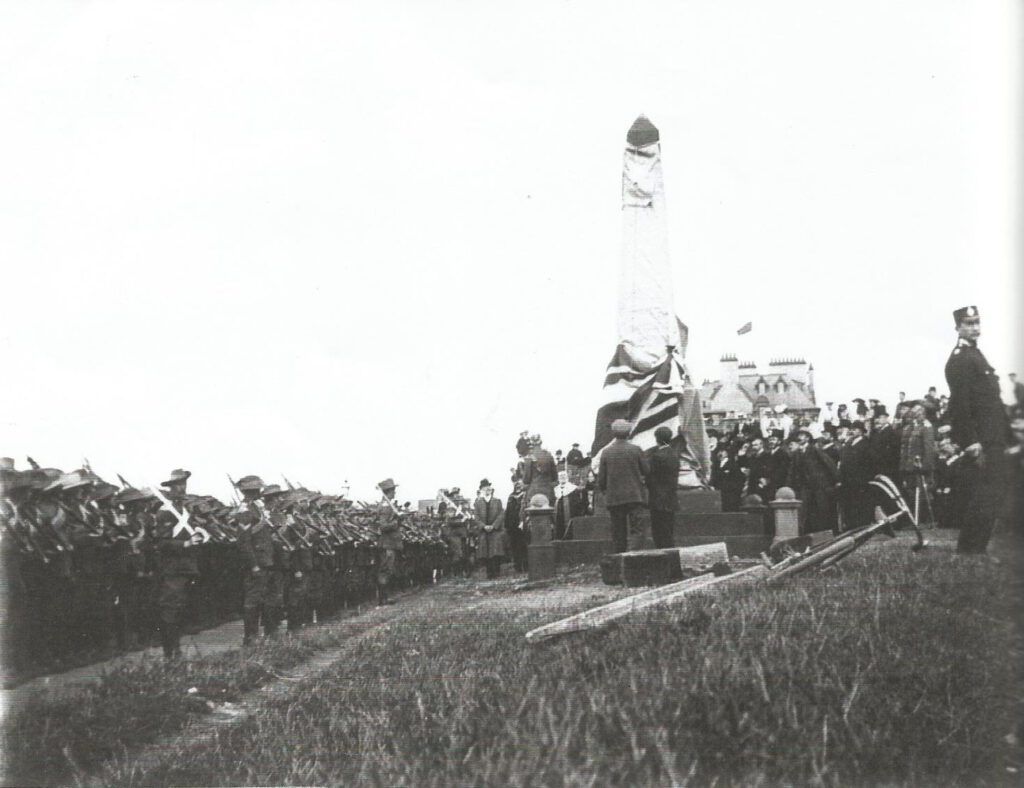
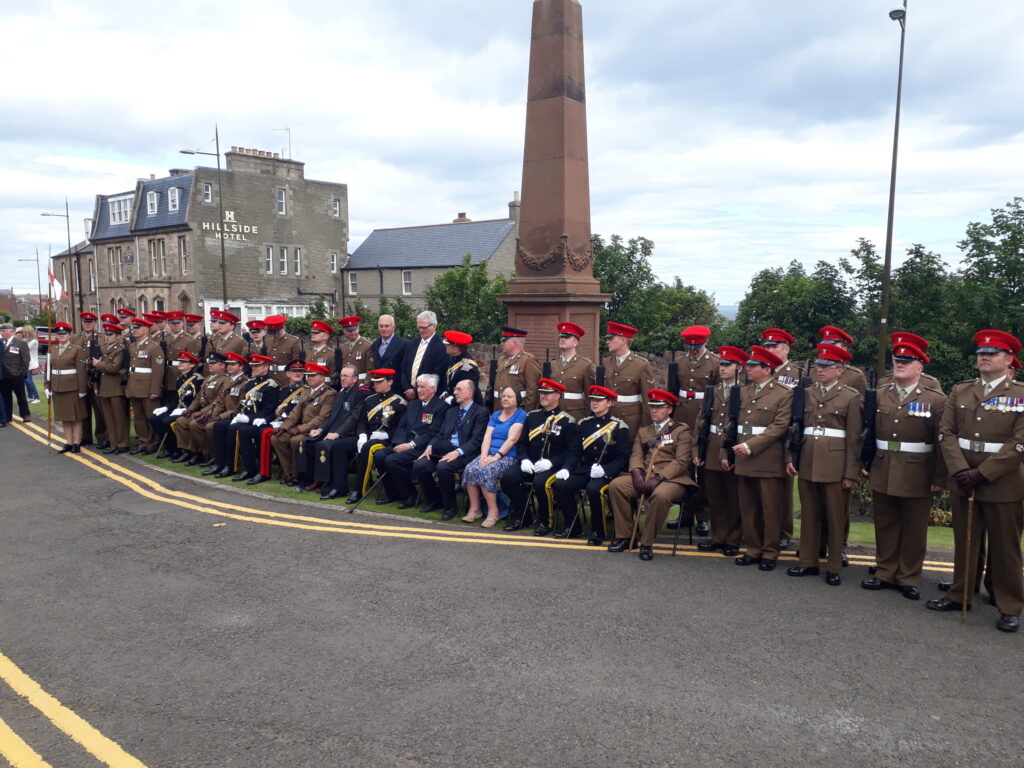
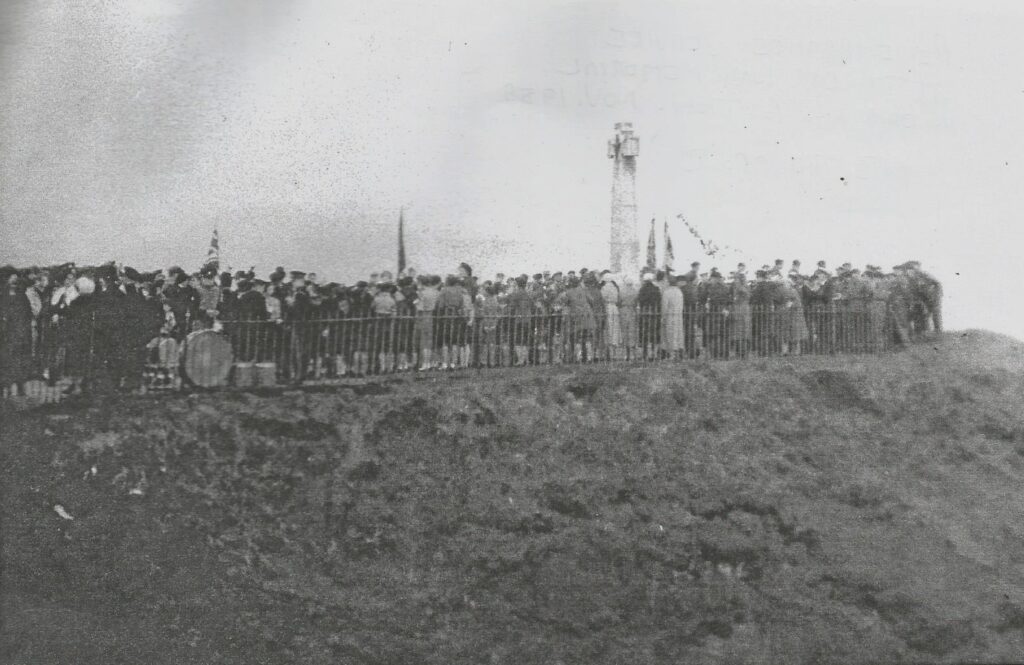

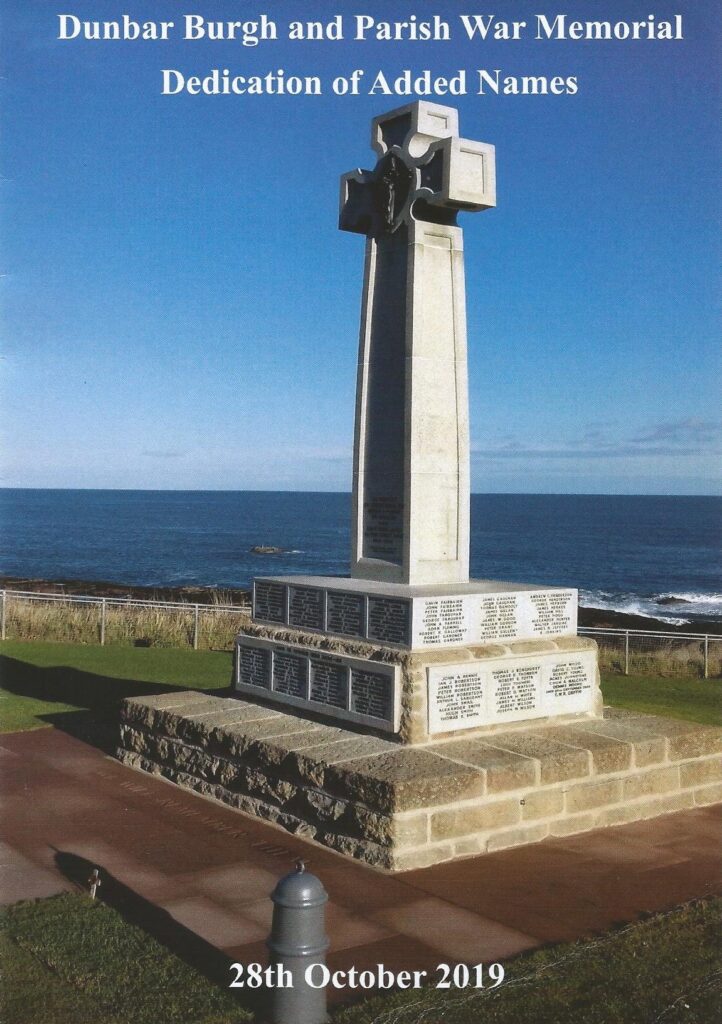
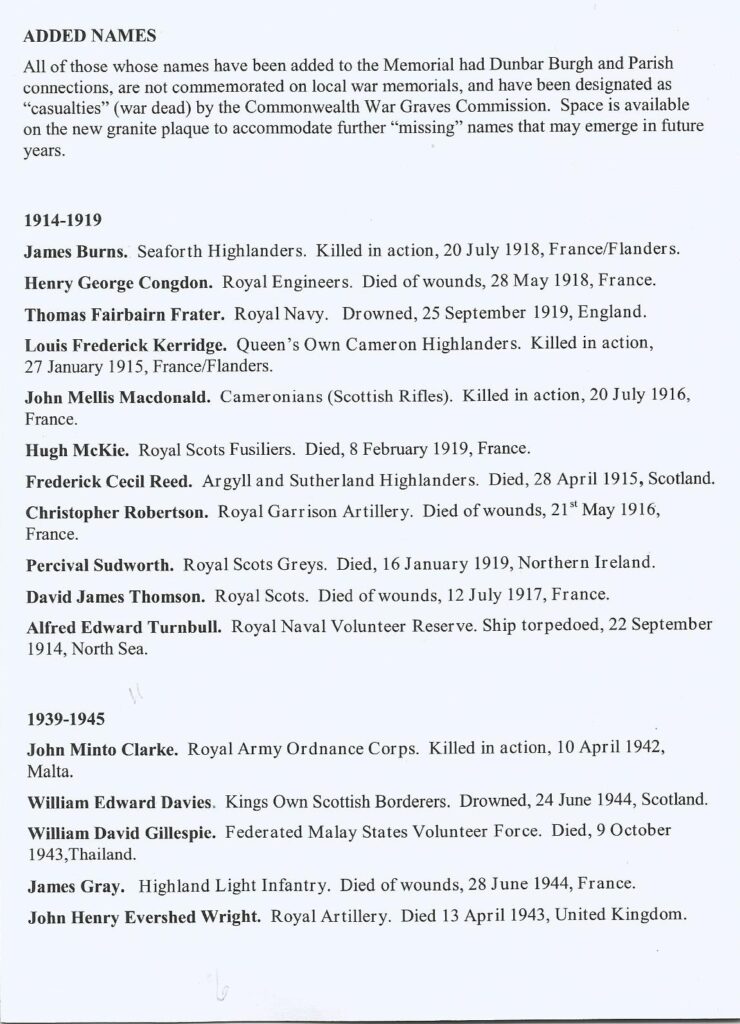

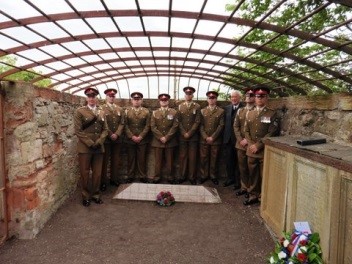


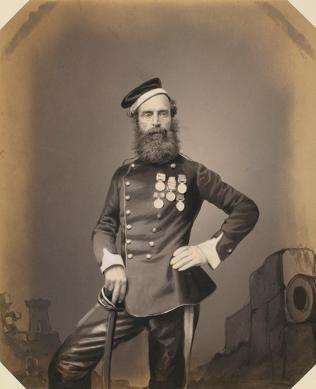
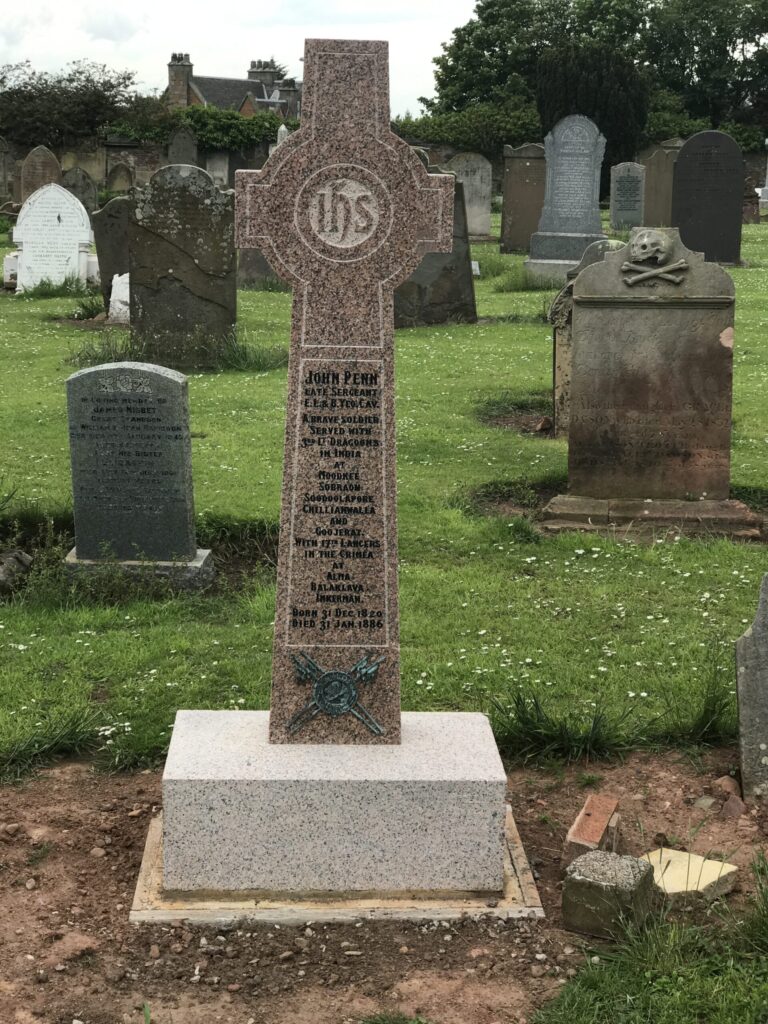
Individual Memorials
The Community Council took action with the cooperation of East Lothian to maintain three graves.
The Andersons of Winterfield
In 2015 it organised an improvement of the burial enclosure of the Andersons of Winterfield for the visit of 1 RHA to commemorate the part played by Major General W C Anderson at Waterloo.
As a Lieutenant, he was sent to recover six Belgian guns. He saved five for which he was given a note of commendation.
He died in 1865 in Edinburgh. His funeral was a grand military occasion as far as Waverley Station. It was simpler in its final stages in Dunbar.
The Community Council also commemorated his brother LT. Col Robert Anderson who was also at Waterloo and subsequently went to St Helena to guard Napoleon. He commanded the (91st Regiment of foot, later The Argyll and Sutherland Highlanders] and died in in 1844. The brothers were both buried in the same family burial ground.
General Sir F R Wingate Bart.
The second grave was that of General Sir F R Wingate, Baronet of Dunbar and Port Sudan, former Sirdar of Egypt and Governor of the Sudan,.High Commissioner for Egypt 1916-19. He was a burgess and freeman of Dunbar [1900] He was created baronet in 1920. He was Hon Col of 57th Regt RA TA [later 357],the local TA Regt, from 1922. He died in Dunbar on 28th Jan 1953. The Regiment conveyed his body on a gun carriage from St Anne’s church to the church yard on 3rd February 1953.He was a benefactor of Dunbar. His tombstone was restored at the request of The Community Council in 2018 by East Lothian Council and with a financial contribution from The Royal Artillery Council for Scotland.
Sergeant John Penn
The attention of the Community Council was drawn to the state of the tombstone in the churchyard in Dunbar commemorating Sergeant John Penn [1820-86].
Penn’s tombstone is of interest because of the part he played in the military history of the 19th century. It had been declared unsafe. Fortunately, I was able to persuade the council officers that it was of historic importance and I was able to say that Dunbar Castle Lodge had agreed to meet the cost of the restoration.
Penn was born in Brighton in 1820. He joined the cavalry as soon as he reached the standard height. He was involved in many campaigns in India. He came back to Britain in 1853 and then volunteered for the 17th Lancers and went to the Crimea. The Crimean war lasted from Oct 1853 until Feb 1856.Britain joined in 1854 Russia and Austria were opposed by The Ottoman [Turkish] Empire, France, Britain and Sardinia. It was fought over access to Holy places in the Holy Land. It ended with the Treaty of Paris
The Charge of the light Brigade was in the Battle of Balaclava on 25th October 1854. It was a terrible mistake but the troops fought with incredible courage. Tennyson’s poem immortalised it with the words ‘into the mouth of hell rode the 600.’Only a few came back. Penn was involved and survived. He is referred to for his courage in Nolan’s account of the Crimea. In an account published in the United Services Gazette of 1877. it is said he holds more medals for bravery and soldiership than any other man in Her Majesty’s service. In 1863 he left the army and came to Dunbar and joined the East Lothian and Border Yeomanry as a sergeant instructor.
He was a member of the Dunbar Lodge of Freemasons and became a local celebrity. Local gentry made it possible for him to attend the annual Balaclava banquet. He died in January 1886. His funeral fully described in the Courier of the 5th Feb 1886 was a major event. His coffin was wrapped in a royal ensign and on it was his helmet, sword and two wreaths supplied by Miss Nisbet Hamilton of Biel. It was carried from his home in the High Street to St Anne’s chapel [The Iron Church. The present stone church was not opened for worship until 1890]. The coffin was followed by a horse draped in funeral apparel. The Rev A Broad conducted the service. The coffin was taken by various bearer parties, made up from the military and also a Masonic party to the churchyard at the other end of the town. There was a huge military presence. Many having come from Edinburgh. The streets were crowded with the townspeople and others. Amazingly his coffin was lowered into the grave by Mr John Penn[son], Colonel, the Earl of Haddington, Colonel Anderson of Winterfield, Major Pym, Captain Waldron and other officers. Three volleys were fired, and the band played between them. Thus, was the hero of Balaclava committed to the dust. It was a truly exceptional event.
‘No man in East Lothian was better known than Sgt Penn ‘[said in 1886].
We want to keep his memory alive. Clearly, he was a remarkable man and his grave should be of wide interest to the Lothians and Border Horse, to the people of Dunbar and to others from far afield.
’Let us now praise famous men and our fathers that begat us’
Remembrance Service
In view of the prevalence of Coronovirus Dunbar Community Council held a simple commemoration of VJ Day at 11 am on 15th August 2020
Royal Charter
On the 16th August 1445 James 2nd, King of Scots, granted a charter, creating The Royal Burgh of Dunbar.
Stephen Bunyan 15 08 20
References
Haddington Advertiser 1/8/1902
*Dunbar, A Garrison Town, with Casualties of Three Wars R J M Pugh
Wingate Local Hero ELA&F Nat Transactions Vol 28 2010 Stephen Bunyan [ available as a monograph item in Dunbar Local History Room.]
Wingate Pasha by R J M Pugh, Pen & Sword, Military 2011
The Andersons of Winterfield by Stephen Bunyan, Document held by Dunbar History Society
You must be logged in to post a comment.